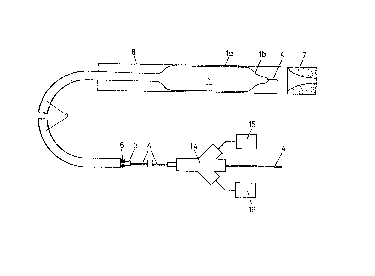Some of the information on this Web page has been provided by external sources. The Government of Canada is not responsible for the accuracy, reliability or currency of the information supplied by external sources. Users wishing to rely upon this information should consult directly with the source of the information. Content provided by external sources is not subject to official languages, privacy and accessibility requirements.
Any discrepancies in the text and image of the Claims and Abstract are due to differing posting times. Text of the Claims and Abstract are posted:
| (12) Patent: | (11) CA 2037404 |
|---|---|
| (54) English Title: | ANGIOPLASTY LIGHT GUIDE CATHETER |
| (54) French Title: | CATHETER A FIBRE OPTIQUE POUR L'ANGIOPLASTIE |
| Status: | Expired and beyond the Period of Reversal |
| (51) International Patent Classification (IPC): |
|
|---|---|
| (72) Inventors : |
|
| (73) Owners : |
|
| (71) Applicants : |
|
| (74) Agent: | SMART & BIGGAR LP |
| (74) Associate agent: | |
| (45) Issued: | 1998-03-31 |
| (22) Filed Date: | 1991-03-01 |
| (41) Open to Public Inspection: | 1991-09-06 |
| Examination requested: | 1991-03-01 |
| Availability of licence: | N/A |
| Dedicated to the Public: | N/A |
| (25) Language of filing: | English |
| Patent Cooperation Treaty (PCT): | No |
|---|
| (30) Application Priority Data: | ||||||
|---|---|---|---|---|---|---|
|
An angioplasty balloon catheter wherein the
balloon thereof has connectad to its wall a plurality
of laser light guides which are inlaid in the balloon
wall so that the distal ends of the liyht guides can be
moved radially outwardly and inwardly by changing
pressure within the balloon.
Cathéter à ballonnet pour angioplastie dans lequel le ballonnet comporte sur ses parois une série de guides de lumière laser, qui sont incrustés dans les parois du ballonnet. Ainsi, les extrémités distales de ces derniers peuvent être déplacées radialement vers l'extérieur et vers l'intérieur en modifiant la pression à l'intérieur du ballonnet.
Note: Claims are shown in the official language in which they were submitted.
Note: Descriptions are shown in the official language in which they were submitted.

2024-08-01:As part of the Next Generation Patents (NGP) transition, the Canadian Patents Database (CPD) now contains a more detailed Event History, which replicates the Event Log of our new back-office solution.
Please note that "Inactive:" events refers to events no longer in use in our new back-office solution.
For a clearer understanding of the status of the application/patent presented on this page, the site Disclaimer , as well as the definitions for Patent , Event History , Maintenance Fee and Payment History should be consulted.
| Description | Date |
|---|---|
| Inactive: IPC removed | 2021-10-18 |
| Inactive: IPC assigned | 2021-10-18 |
| Inactive: IPC expired | 2013-01-01 |
| Inactive: IPC deactivated | 2011-07-26 |
| Inactive: IPC from MCD | 2006-03-11 |
| Inactive: First IPC derived | 2006-03-11 |
| Inactive: IPC from MCD | 2006-03-11 |
| Inactive: IPC from MCD | 2006-03-11 |
| Time Limit for Reversal Expired | 2003-03-03 |
| Letter Sent | 2002-03-01 |
| Inactive: Late MF processed | 2000-03-27 |
| Letter Sent | 2000-03-01 |
| Grant by Issuance | 1998-03-31 |
| Inactive: Final fee received | 1997-11-28 |
| Pre-grant | 1997-11-28 |
| Letter Sent | 1997-10-27 |
| Notice of Allowance is Issued | 1997-10-27 |
| Notice of Allowance is Issued | 1997-10-27 |
| Inactive: Application prosecuted on TS as of Log entry date | 1997-10-23 |
| Inactive: Status info is complete as of Log entry date | 1997-10-23 |
| Inactive: First IPC assigned | 1997-10-03 |
| Inactive: IPC removed | 1997-10-03 |
| Inactive: IPC assigned | 1997-10-03 |
| Inactive: IPC removed | 1997-10-03 |
| Inactive: IPC assigned | 1997-10-03 |
| Inactive: Approved for allowance (AFA) | 1997-09-11 |
| Application Published (Open to Public Inspection) | 1991-09-06 |
| All Requirements for Examination Determined Compliant | 1991-03-01 |
| Request for Examination Requirements Determined Compliant | 1991-03-01 |
There is no abandonment history.
The last payment was received on 1997-11-05
Note : If the full payment has not been received on or before the date indicated, a further fee may be required which may be one of the following
Patent fees are adjusted on the 1st of January every year. The amounts above are the current amounts if received by December 31 of the current year.
Please refer to the CIPO
Patent Fees
web page to see all current fee amounts.
| Fee Type | Anniversary Year | Due Date | Paid Date |
|---|---|---|---|
| MF (application, 7th anniv.) - standard | 07 | 1998-03-02 | 1997-11-05 |
| Final fee - standard | 1997-11-28 | ||
| MF (patent, 8th anniv.) - standard | 1999-03-01 | 1999-02-23 | |
| Reversal of deemed expiry | 2000-03-01 | 2000-03-27 | |
| MF (patent, 9th anniv.) - standard | 2000-03-01 | 2000-03-27 | |
| MF (patent, 10th anniv.) - standard | 2001-03-01 | 2001-02-19 |
Note: Records showing the ownership history in alphabetical order.
| Current Owners on Record |
|---|
| SCHNEIDER (EUROPE) AG |
| Past Owners on Record |
|---|
| EUGEN HOFMANN |